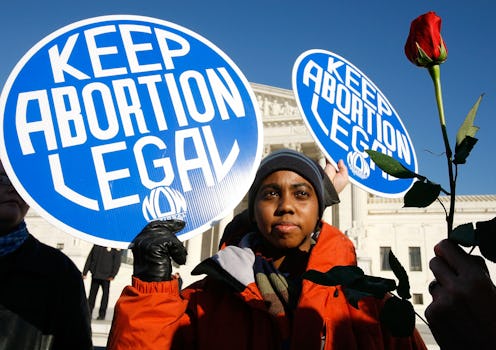
Since Trump's election, debate over abortion rights has been more fervent than ever in the United States. But what's often missing from these debates is what actually happens when you limit abortion access. Whether you believe abortions are morally justified or not, you should care whether or not the many restrictions our federal and state governments have proposed and enacted over the past few years are actually lowering abortion rates — and what other effects they could be having. We should all care about it.
The abortion rate in the United States is actually the lowest it's been since the Guttmacher Institute started tracking it in 1973. It might seem like this means government restrictions have decreased abortion rates, but it may have more to do with access to affordable birth control — something that's also in danger. While the goal of people who advocate overturning Roe v. Wade or defunding Planned Parenthood may be to make people give birth instead — and there likely are cases when this happens — evidence suggests that people who can't get abortions legally and safely will often resort to illegal, unsafe measures.
Here are a few things that have been shown to happen when people lack access to abortion.
1Abortion Rates Don't Go Down
Presumably, people who advocate for laws restricting or prohibiting abortion access believe these laws will lead to fewer abortions. But evidence actually suggests that's not the case. A study published in the Lancet last year found that there were actually slightly fewer abortions (34 for every 1,000 women compared to 37) in countries where abortion was legal. This suggests that if someone is determined not to start a family before they're ready, the law will likely not make a difference. At best, the rates will stay the same — except that the risks will be much higher.
Speaking of...
2Abortions Become Less Safe
One reason abortion rates are roughly the same in places where doctors aren't allowed to perform them is that they're not all being performed by doctors. A 2015 University of Texas at Austin study found that 1.7 percent of Texas women had attempted to perform abortions on themselves — and this number is probably increasing. A 2016 New York Times analysis of Google search data found that more people began researching how to self-induce abortions since states started cracking down on abortion rights in 2011.
3Mental Health Suffers
A study published last year in JAMA Psychiatry found that women who were denied abortions had less self-esteem, higher anxiety, and less overall satisfaction than those who were able to get them. This isn't surprising, since feeling like we have control over our lives is essential to our mental health, clinical psychologist Dr. Claire Dowdle told Bustle when the study came out.
4People Jump Through Hoops To Get Abortions
When abortions are technically legal but difficult to access, people end up having to travel to other states, wait long periods of time, and go through emotional trauma in order to obtain them. A study published last year in the in the American Journal of Public Health found that after the passage of Texas's HB2, which closed over half of the state's abortion clinics, women spent more money and traveled four times the distance to get abortions.
5Teen Pregnancy Rates Don't Go Down
Some abortion opponents may also argue that the option of legal abortion makes more people have unprotected sex since it holds fewer consequences. But that's also not true. Switzerland, where abortion is legal during the first 12 weeks of pregnancy, has the lowest rate of teen pregnancy in the world, according to a study in the Journal of Adolescent Health, and its abortion rates have only gone down since it made abortion more accessible. Next was the Netherlands, where abortion is legal for up to 24 weeks. Sex education and access to birth control are more likely to impact teen pregnancy rates.
6Birth Control Usage Probably Doesn't Go Up
The fact that pregnancy rates seem unaffected by abortion law may result from the lack of relationship between abortion access and birth control usage. A study in Global Public Health found that most people do not view abortion as an alternative to contraception. The majority of women who'd had abortions either had used birth control over the past month or were at a low risk for pregnancy. So, for folks who think people should neither have access to abortion or access to birth control because the only time you should be having sex is if you want to have babies... well, your logic is flawed, to say the least.
7Wealth Inequality Increases
A University of California-San Francisco study found that two thirds of American women seeking abortions between 2008 and 2010 were living below the poverty line, largely because they could not afford to care for children. This was also the population most likely to be denied an abortion. These women ended up getting abortions later into their pregnancies and traveling further for them, which led their abortions to be more expensive than those obtained by women with higher incomes. The end result was that wealth inequality widened, which has lasting consequences for not just pregnant people but also their entire communities.